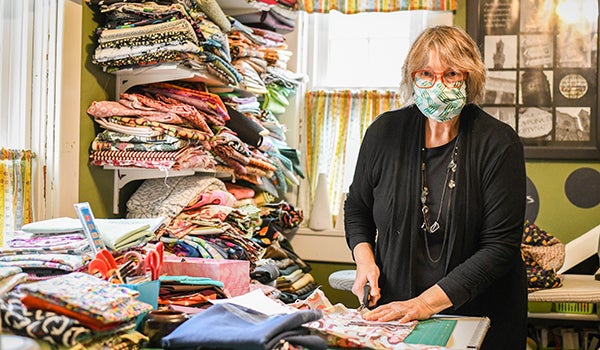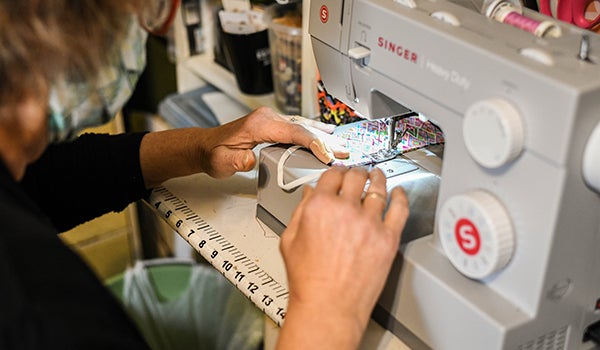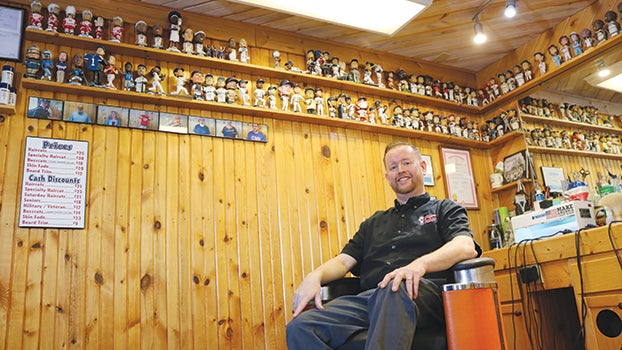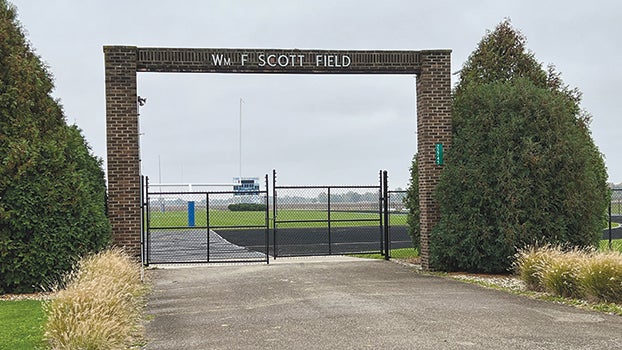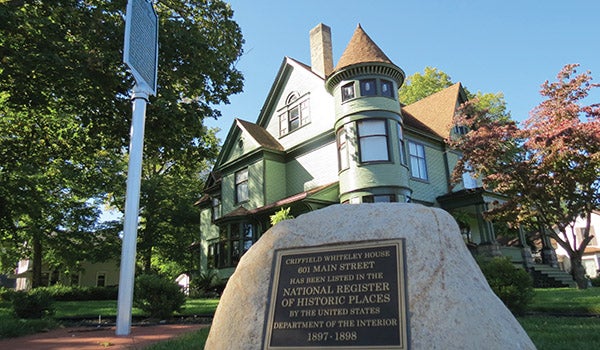Dowagiac woman uses love for sewing to create, distribute thousands of homemade masks
Published 8:25 am Friday, March 5, 2021
|
Getting your Trinity Audio player ready...
|
Diane Barrett-Curtis describes her sewing room as “organized chaos.”
Located at the top of a tall staircase inside her Dowagiac home, the room — titled Curtis Clothing Co., according to a sign hanging above the doorknob — lives up to the 69-year-old woman’s description.
Piles of fabric in every color burst out of ceiling-high shelves and litter every available inch of space. On a worktable in the room’s center rests dozens of half-cut squares — some plain, some with dots, others adorned with the smiling face of a lion or bunny. Next to the table sits one of her favorite parts of the space — a box stocked to the brim with empty spools of thread, each one used up during the year 2020.
“My fabric and thread collections have been growing for years,” Curtis said as she gave a tour of the room, stopping every so often to tell the history of one fold of fabric. Many she picked up during sales at JoAnn Fabrics. Others she hunted for, knowing that a specific color or pattern would brighten someone’s day. “As you can see, when I’m working, I just somehow end up with piles of fabric everywhere.”
Since March, Curtis has been spending a lot more time than usual in the sewing space. Most days, she can be found sitting in front of the sewing machine, her TV working double-time streaming reruns of “The West Wing” as she stitches together square after square of fabric.
Her months of dedication have not been without cause. Since the beginning of the COVID-19 pandemic, Curtis has hand-sewn nearly 3,000 masks to be donated to individuals and groups in need across the country.
“Some people are ‘crazy cat ladies,’ but I guess you could say I’m a ‘crazy mask lady’ now,” Curtis said, letting out a laugh.
Though Curtis had long enjoyed sewing, when the clock struck midnight on Jan. 1, 2020, there was no way she could have known she would spend the majority of the year sewing every kind of mask imaginable. However, when the COVID-19 pandemic hit the state of Michigan in March, she knew she needed to help.
“I just feel like this is what I can do and what I can contribute right now,” said Curtis, who has lived in Dowagiac since she was 5 years old. “I’m not a health care worker. I can’t help in that respect in taking care of people, but I can help people stay safe, so that’s what I am going do.”
Though she is retired, Curtis typically volunteers several times a week at Justus Gage Elementary School to read to students. When COVID-19 kept her away from the schools physically, her masks gave her a tie to the school and the students she loved.
Sarah Proctor, an elementary teacher at Justus Gage Elementary School, said Curtis sewed matching masks for her entire second-grade class. Though the masks were little more than two loops of elastic connected by a pleated strip of polka-dotted fabric, Proctor said the masks not only kept her students safe from COVID-19, but also gave them something to bond over.
“In an age of social distancing, [the masks] build unity,” said Proctor, 39. “The kids get really excited that they all have the same masks. We can’t sit in a circle. We can’t gather in a small group because we need to be spaced out. This is one more thing to bring us together, and for Diane to have given that to us is such a blessing.”
After the first few batches of masks were distributed, it did not take long for Curtis’ facial coverings to make it outside of her hometown. While she initially planned only to make a small number of masks, requests soon came pouring in from those in need. Once she started joining mask-making groups on Facebook, she began to help fill requests from businesses, organizations, hospitals and Native American tribes asking for masks. To date, her masks have gone as far as North Carolina, Oklahoma, New York, Florida, Texas and California, in addition to several cities within Michigan.
One who reached out for assistance with masks was Erik Hutchinson, a 36-year-old psychiatric social worker from Ypsilanti, Michigan. A worker within the Henry Ford Health System, he and his coworkers cannot wear hand-sewn, non-medical grade masks inside the hospital in which they work. However, the healthcare workers still needed masks to wear to and from the hospital and in their everyday lives. Hutchinson, who knew Curtis from when he lived in Cassopolis years ago, contacted her for help, and Curtis delivered. Not only has she sent Hutchinson 150 masks to date to distribute to healthcare workers in the metro-Detroit area, but she also sent homecooked brownies and cookies to help lift their spirits.
“It feels like a strong support, like we are being taken care of,” Hutchinson said through the crackle of a phone line. “If I could say one thing to [Curtis], it would be: ‘Words can’t express the love and support we feel when we open our gift box from you. Thank you for supporting us through this pandemic.’”
Another healthcare worker to receive masks from Curtis was Angel Sundman, a 58-year-old occupational therapist. Though she now lives in St. Clair Shores, Michigan, Sundman grew up across the street from Curtis, and when she heard her former neighbor was making masks, Sundman reached out.
After months of stressful, dangerous work on the frontlines of the COVID-19 pandemic, Sundman said the masks Curtis sent felt like an act of compassion and appreciation that brought tears to her eyes.
“I was amazed when I got my first two in the mail, and Diane wouldn’t take a dime even though I wanted to contribute,” Sundman said, apologizing for the emotion flooding into her voice. “To get a little piece of home in the mail, it was a little lifeline that came in the mail in a time when we just needed caring and compassion. Diane is an awesome, incredible human who has made her mark on this planet and continues to do so.”
Stitching together connections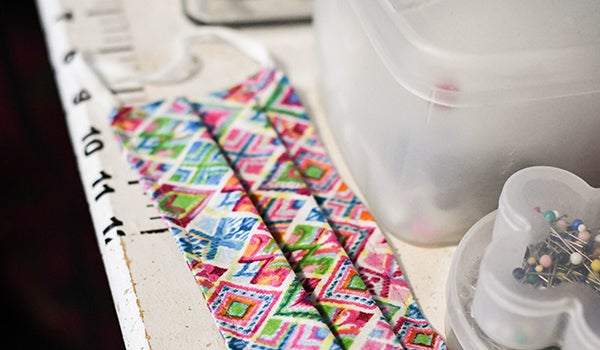
Those who receive Curtis’ masks are not the only ones who benefit, Curtis said. She too has found personal enjoyment and fulfillment from her project.
“It’s been very rewarding for me. I get a couple of people who say my masks are the best,” Curtis said with a smile. “That makes me feel really good.”
Curtis has used the project to learn new skills and has spent countless hours watching YouTube videos to learn about new mask techniques. Once she saw a style of mask she had never seen before in a store. She bought the mask just to take it home, take it apart and learn how to make it herself.
“It’s amazing to me all the different YouTube videos there are,” she said. “I’m always down to try a different mask. I usually give them to my husband to test them and say, ‘here, let me know how you like it.’”
In addition to giving her an outlet to test her sewing skills, Curtis said the project has helped her keep her mind off the pandemic and political turmoil around her. In addition to having to cancel trips and be isolated throughout the pandemic, Curtis’ daughter was fighting cancer in 2020. Because of COVID-19 precautions, Curtis could not be with her daughter while she was in the hospital, something Curtis said was painful for her to endure.
When the stress of the outside world became too much, Curtis said she at least had her sewing room and project to turn to — giving her a purpose and a connection to everyone she sent a mask to.
“Truthfully, if I hadn’t been sewing, I don’t know what I would have been doing these past few months,” Curtis said. “Sewing has given me a bit of a release so I can keep my mind off of other garbage.”
Despite the outlet it has given her, Curtis said there had been several times she thought she was done making masks. However, whenever she is about to put down her fabric scissors, she will get another request for a mask order, and she will march back up to her sewing room to complete it.
“As long as I think there is a need for it, I will keep making masks,” Curtis said. “I don’t go out of my way to find people, but they keep happening to find me. I’m glad for that.”


